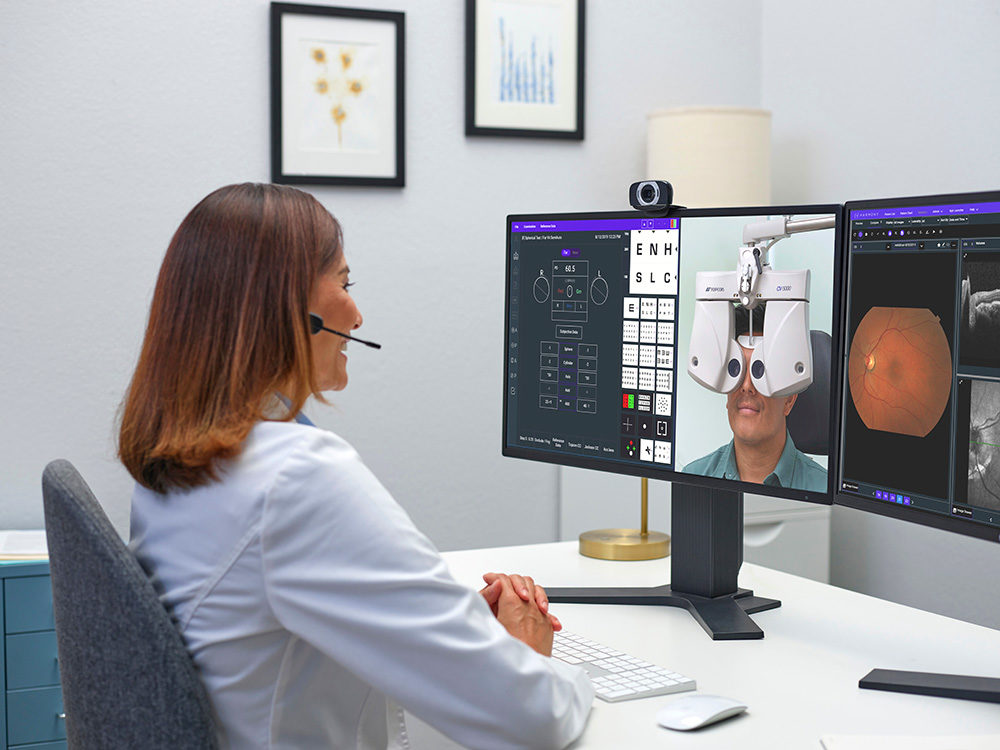
Benefits of Remote Refraction
As an optometrist who has spent years manually and digitally refracting patients, heading into a virtual realm has required a slightly different approach to the way I practice; however, the remote refraction process is not that different from using the CV-5000S digital phoropter in the office. The main difference is that rather than using a manual control panel in the examination room, the clinician is instead using a computer interface and mouse at a remote location to control the phoropter head. I like that the Topcon RDx platform is intuitive and easy to start using. A technician is still needed to set up and align the patient before the refraction starts, but once the program is up and running, the sequence of steps is the same as an in-person refraction. The more we use the technology, the more seamless and integrated it’s becoming in our day-to-day clinical examinations.
Patient & Provider Benefits of RDx Technology
In practice, we have found that the patients’ early experience with this new way of refracting has been overwhelmingly positive. After a recent remote refraction on a patient, the young woman gave us her impression of the process: “I was told prior to my exam that I would be getting a remote refraction from a clinician that would be offsite. This new examination process was so easy and was as if the doctor was still in the room with me!” She liked the efficiency that remote refraction offered, noting: “It’s nice just to be able to walk in, have a seat, video connect with the doctor and start the refraction process. I really liked that I didn’t have to wait. Sometimes in busy practices the doctors are running behind schedule, but with the remote refraction, I was able to get in front of the video screen with Dr. Ngo right away and he quickly refracted me and provided a new prescription.” This patient also appreciated the additional flexibility and convenience that remote refraction offered. She said, “You have more choices now based on your schedule or what doctor you prefer to see, because the doctor does not have to physically be in the office to see you. For people who are super busy and have fast-paced lifestyles, I think the convenience and time savings with remote refraction is going to be a big value moving forward.” As an eye care provider, I also value flexibility in my professional life. Remote eye exams and refractions are especially helpful if I am travelling, unable to make it into one of our offices or need to work from home. In the past, one of the main drawbacks of being an eyecare professional was that you couldn’t provide care to patients and work from home at the same time. Now that we have the ability to remotely conduct eye exams, including refractions, that opens up options for doctors who may mix in-person and remote work, switching between the two to suit their personal needs and allowing a better quality of life.
Utilization Today
In addition to its potential use for many of our routine evaluations, I think remote refraction can help improve access to vision care and fill in service gaps for large and small practices. For example, a patient who has an urgent need for glasses but can’t schedule a live visit with a doctor nearby, could schedule an appointment at a practice offering remote refractions, and quickly obtain a prescription through this virtual service. In addition, high-volume specialty practices that don’t do refractions might consider adding remote capabilities to offer a more comprehensive eye exam for their patients. Another application could be for small optical shops that can’t afford a full-time optometrist but could hire someone part-time to manage remote refractions. While remote refraction is an excellent fit for many patients, certain patients might not be ideal candidates. Those individuals could include patients with large degrees of astigmatism, or those who have conditions such as keratoconus or more complicated pathologies that require in-person or follow-up evaluations. Young children or elderly patients may not be as well-suited for remote refraction. I estimate that 60% to 70% of my patient population might enjoy utilizing this new technology, in particular, “computer-age” patients like Millennials, Generations X and Z who have a comfort level with innovation and virtual technology. In all cases, it will be exciting to see where remote refraction will take eye care now and into the future.

ABOUT THE AUTHOR
Ryan Ngo, OD, is an optometrist at Denny Eye & Laser Center in San Francisco. He formerly practiced at Union Square Eye Care in New York City.

Topcon RDx® and the CV-5000S Digital Phoropter Benefits the Patient and the Practice
Topcon RDx®, an ocular telehealth platform enables eye care providers to connect to their offices remotely and conduct portions of the comprehensive eye exam. Topcon’s CV-5000S automated phoropter integrates with RDx remotely, so practitioners can perform refractions from anywhere.



